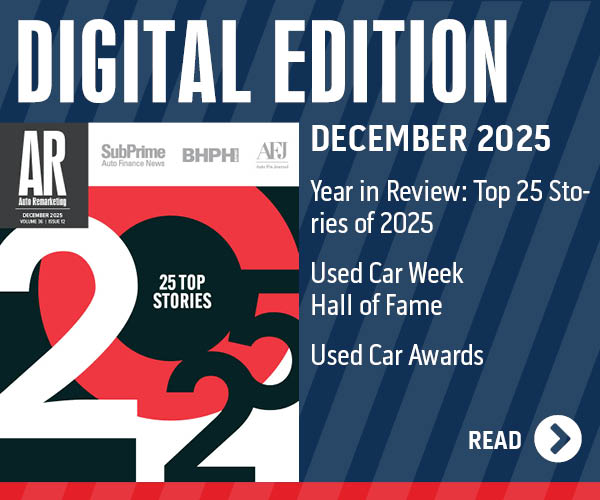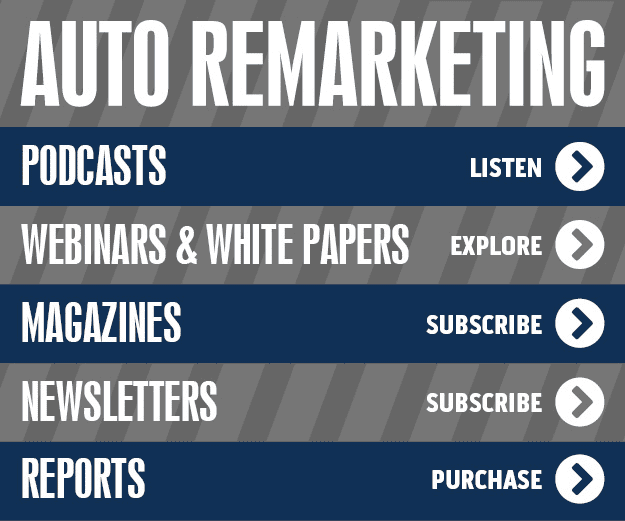GPS telematics products provider PassTime recently announced it has hired Blair Witter as the company’s new vice president of sales for the Southeast region.
Witter brings with him decades of industry experience, coming from Credit Acceptance. Witter worked at Credit Acceptance for nearly 11 years, serving as a market area manager and more recently as director of sales.
“We are excited to bring Blair on as the VP sales for the Southeast region. We think he is a great fit for PassTime. He brings a great deal of experience with him, and we look forward to growing the region together,” said Chris Macheca, chief operating officer at PassTime.
As director of sales at Credit Acceptance, Witter oversaw a team of market area managers who selected and consulted with franchised and independent dealers to deliver contracts on the Credit Acceptance program. During his time there, Credit Acceptance was named Fortune’s Top 100 Greatest Places to Work in America three times in a row, a testament to the culture built at the company.
Prior to his work at Credit Acceptance, Witter also founded and managed two large-volume dealerships in Biloxi, Miss., and Mobile Ala., for more than a decade.
For more information about PassTime, contact the company at (877) 727-7846 or [email protected].
In the latest installment of the annual Best of BHPH issue of BHPH Report, we go behind the scenes with some of the leading companies in the used-car space and their top executives with a few Q&A features.
Next up in this series is Brent Carmichael, executive conference moderator of 20 Groups at NCM Associates.
BHPH Report: What’s your assessment of what it’s been like for the typical BHPH dealer in 2016?
Brent Carmichael: It’s been a lot tougher. Subprime is still the main competitor for us. They’re still really aggressive even though we’re starting to hear that it’s starting to taper off in some areas. But most of them are still pretty aggressive.
The regulatory side of the business obviously has a lot of dealers concerned. The general feel is that lot traffic is down, so there’s not as many people in the market overall. There are just fewer customers to sell to at this point.
From a collections standpoint, there is a little heightened level of frustration with getting customers to pay and pay on time. There seems to be more of a lackadaisical attitude with the customer base as far as making their payments. I think a lot of that’s driven by they have more options now than they ever have before. If they don’t like the car or are having issues with the car or don’t like the way they’re being treated from a collections standpoint, they’ll just give up and go somewhere else to buy a car. It’s been tougher this year than it has the past couple of years, that’s for sure.
BHPH Report: How much more receptive to new ideas have dealers been in your 20 Group meetings this year?
Brent Carmichael: They’re much more receptive. They’re still looking for that silver bullet. Some of them who were kind of closed-minded in the past about changing their business model are starting to look at different business models.
As an example, some used to say that they would never take on a subprime retail environment and now they’re looking at doing that. Some are looking at a higher (actual cash value) car. They are probably more open-minded to change now than they’ve ever been because they realize the subprime thing is not going to go away. The competitive market is going to be there. In the past, we’ve been able to sit back and ride it out for 18 months or maybe two years at the most. But we’re going on year three, and it doesn’t look like it’s going anywhere. Now they’re looking at anything they can do differently. They might even look at something completely different.
Some are even looking to get out of the business at this point, that now might be a good time to exit the business with the current environment and what the future might hold.
BHPH Report: How difficult has it been for operators to work with their customers to keep them current on their contracts?
Brent Carmichael: That’s something we’ve always had the ability to do. We can set our policies and procedures so we can let them be as delinquent as we want to and work with them as much as we can, obviously unless there’s some sort of bank covenant or line of credit covenant that might restrict some of that.
Again, we’ve had dealers in the past who were pretty strict on their collections guidelines who now have opened up and are willing to adjust accounts or accept deferred payments if it’s necessary to keep the customers. They’ve become more open-minded and understanding the value of a customer is probably higher now than it’s ever been. They’re trying to help everyone who is at least trying to make their payments. Some of the customer base hasn’t taken as much pride in ownership as they have in the past, so dealers are more open to working with the ones who are really trying.
Back when I used to be a dealer, we expected the payment to be made on or before the due date. Now we understand that life issues happen and work with customers more than we have in the past.
BHPH Report: What industry trends are you watching as we go into 2017?
Brent Carmichael: With the new ruling against the CFPB and how it’s structured, how that’s going to shake out, I don’t know when we’ll see any benefits of that in the near future. But that’s something that obviously could impact the landscape moving forward.
I think the main focus for most dealers believe it or not is just back to basics more than anything else. They might not be looking to buy the next latest, greatest thing, rather looking internally and making sure they’re doing everything from a blocking-and-tackling standpoint.
Inventory used to be a big issue but it’s not so much anymore. I’m hearing from dealers currently in the group that auction prices are down, so that’s starting to look up for us. There is starting to be some inventory freed up, so that should be a positive going into 2017.
Still the regulatory environment, exactly what rules are we supposed to follow and how we’re supposed to play by them, that’s probably the biggest concern moving forward.
Additional pieces from this series can be found below:
4 questions with Ace Christian of the Arizona Independent Automotive Dealers Association
4 questions with Bill Caan, national sales manager at CalAmp
In the latest installment of the annual Best of BHPH issue of BHPH Report, we go behind the scenes with some of the leading companies in the used-car space and their top executives with a few Q&A features.
Next up in this series is Bill Caan, national sales manager at CalAmp.
BHPH Report: Since they’ve been used for several years now, how much have payment devices and GPS tracking systems changed the way auto financing occurs in this area of the credit market?
Bill Caan: There’s been a couple of big changes. One is the sophistication of the devices themselves, whether it be going from 2G to 3G or the functionality that the devices offer. They allow a lot more flexibility in the way you can collect on your loans. That being said, it gives you the ability to underwrite more aggressively with the idea that if the loan goes sideways, I can protect my collateral because I can monitor my collateral.
One of the things that will happen over the next couple of years, if it’s not happening already, is that finance companies will start to use GPS tracking devices to monitor risky behavior after the loan has been made. By that I mean, if you think about, everyone has their underwriting scorecard and that’s how you decide how to make the loan. There’s a risk associated with every customer whether it’s credit score, income or down payment, the car. Now you have these GPS devices that can detect risky behavior after the loan has been made. Once you agree to it and fund it, it’s yours. There’s nothing you can do about it. But the GPS devices now are going to help collectors determine when risky activity is happening. They’re going to be able to decide, say, if you got an impound lot alert. The procedure can be to go get the car after one day. If the customer is outside of a 300-mile radius from where he bought the car, that’s potentially risky. If the car hasn’t been driven in a week, that could be risky.
I’m not sure you can manage the incidents, but you could manage the severity of loss. We view GPS devices as being able to cut down on the severity of losses because they’ll have the information when risky activity is happening in the field.
BHPH Report: How careful do BHPH operators need to be as not to soften underwriting simply because of devices’ capabilities?
Bill Caan: You have to be real careful. If you go back to Lending 101, you look at ability to pay, stability and willingness. I’m going to put this guy in a loan he can afford. And based on his credit history, he’s willing to take his paycheck and pay it. You start there.
There’s a false sense of security if you think you can make a loan to anyone because I can just stick a GPS on there. You have to be real careful with that because a buy-here, pay-here dealer controls both sides of the equation. He does the underwriting and the collecting. It’s his money and his car.
If you make a loan just because there’s a GPS on the car, the fact that you get your car back isn’t great. You never want to pick up the car because it’s the last-ditch effort. But at least a buy-here, pay-here dealer can just put it back on the lot and away they go.
But people who underwrite with the GPS on there, you have to take into account what your remarketing costs are as well as the fact the GPS is great when the customer hasn’t tampered with it and it still works. That’s another issue.
You just have to be real careful when you change your underwriting saying I can do anything because I have the GPS on there. You have to look at what your recovery and remarketing costs are, too.
BHPH Report: How closely are federal and state regulators watching the use of devices?
Bill Caan: It’s more on a state-by-state basis right now then a federal basis. We’re addressing through our trade organization a new potential bill in New Jersey. I think there are a whole vanguard of people who are starting to look at the use of GPS.
The CFPB really hasn’t come out with a statement on it. I think they’ve got their hands full with what they’ve got going on right now. I think we can all agree that based on what we believe the CFPB isn’t going away.
One of the things that anyone using a GPS program needs to do is absolutely document what they’re doing. Like everything else for the CFPB, you have to have a complaint section. You have to prove there is no disparate impact with the way you’re using them. You have to be really consistent.
I also think one of the issues that’s coming to the forefront is as a buy-here, pay-here dealer you have to be really aware of who your vendors are. You’re not only responsible for what you do, you’re also responsible for what your vendors do. That’s the next step for dealers, to understand who your vendors are.
BHPH Report: How can these devices help other parts of a BHPH dealership’s operation beyond collections?
Bill Caan: We’re starting to address the use of GPS as a data-gathering device instead of just a pure recovery device. If you look at the risk associated with a car loan, if we can start to let the buy-here, pay-here dealers start to monitor their risk post-underwriting and make decisions based on that, you’re going to cut into the severity of loss. I’m not sure you can change the incidents all that much; that’s more of an underwriting standpoint. But if you start to look at culling information from your device — this car hasn’t been driven, or this car is being driven 4,000 miles a week — all of that information is available through the GPS.
Once we get buy-here, pay-here dealers to start to understand that this is valuable information and they can get a handle on what they should do with their collateral, the lower the severity of loss will be. These cars don’t get more valuable. That’s where this market is going.
Additional pieces from this series can be found below:
4 questions with Ace Christian of the Arizona Independent Automotive Dealers Association
In the latest installment of the annual Best of BHPH issue of BHPH Report, we go behind the scenes with some of the leading companies in the used-car space and their top executives with a few Q&A features.
Next up in this series is Ace Christian, chair of Arizona Independent Automotive Dealers Association and owner of Rock Solid Auto Center
BHPH Report: How would you describe the competition your dealership has faced from subprime finance companies working with other stores?
Ace Christian: In 2016 and over the last 30 months, we have seen a lot of competition from subprime finance companies working with other independent and franchise dealers. Consumers with FICO scores between 500-600 used to be our target customers, but today we are lucky if we see 400-500 scores coming to our store.
We have also noticed that customers who have already purchased from us are returning cars earlier than in the past. Our static pool bell curve for repos was at its best between 18-26 months. Today that has changed to where customers are returning vehicles between 8-16 months because they have more options, and subprime finance companies don’t seem to care if the customers return vehicles to us in order to purchase a new car.
So, all that being said, we are seeing a slight slowdown in revenue. The first quarter of this year was not as we hoped it would be. It was better than the year before, but still not as good as 2011-2012. However, in the last six months, we have seen some customers coming back, and some of them have current repos from these subprime companies. I’m not saying that we are seeing a shift, because it’s still too early to tell. If this period of competition is nearing its end, subprime lenders may push hard one more tax season before they exit. If we see a 20-30 percent increase in sales (back to our normal 55-60 sales per month) this next tax season, I will be more inclined to say the tide is turning.
BHPH Report: How difficult has it been to maintain underwriting standards knowing what the competition might be doing?
Ace Christian: This is a good question because it has been a roller coaster ride when it comes to underwriting. We first realized that we were having issues when sales started to fall back in 2013. As we reviewed our whole portfolio and noticed customers were returning vehicles faster, we initially thought we should just sell more cars to replace them. However, this was easier said than done because of our underwriting guidelines. We just weren’t seeing the same types of customers coming in and shopping like we had in previous years.
After a few months and attending some conferences, we realized that competition from subprime companies had arrived, and they were taking our customers on the front end and the back end. Well, our first response was to reach down into the subprime market and buy deeper. We realized after a short period this was not working and we needed another plan. So we decided to reduce our sales goals, lower our overhead costs and reduce staff so we could maintain our underwriting guidelines. We had a decision to make — keep selling at the rate of 55-60 a month or reduce down to 45-50 a month. We decided to be conservative and take the latter.
Even doing that caused us in some months to take more risks on deals we normally wouldn’t do. Otherwise we would have only sold 30 cars in those months. Our decision to reduce cost and sell less was based on how the loans were performing from 18 months ago when we realized that subprime was not backing down and was becoming more aggressive. So we have looked harder at all deals coming in and have reduced our ACVs significantly compared to where we were 30 months ago, so that our risk was reduced.
BHPH Report: What’s it been like to acquire inventory that will turn?
Ace Christian: I’ve been known to say, “When the auction prices get out of line, recycle, recycle, recycle.” Most of the cars we are selling have been from our efforts to recycle the cars charging off to get the most out of the vehicles we have already invested in. As I said earlier, with cars being returned within an 8-16 month period, we have no choice but to reinvest into these cars and resell what we have. We have seen repos coming back needing more reconditioning, but not any more than the cars purchased at auction. There has been some increase in the selection of cars, and auctions seem to be heavy with inventory. Even so, prices have not fallen as much as they should have based on inventory levels, so we are being selective when we do purchase and reinvesting in what we already own. There has been a lot of competition at the auction for the cars we sell, and it doesn’t seem to be slowing down.
BHPH Report: What aspect of your dealership business do you want to improve most in 2017?
Ace Christian: Of course, sales are the No. 1 improvement we would like to make in 2017. If we are unable to do that because of competition, we will continue to reduce costs and improve our processes. We have also invested a lot of time in the last two years becoming compliant in all areas of our business, and we will continue to focus on that. Even though we are small, no one in the BHPH industry should take the government lightly.
Our new objective is on reducing our costs even further and becoming more productive in our processes. The cost of doing business seems to be a big concern for everyone I talk to. Of course, if you’re not selling what you would normally sell, you must trim the fat as much as you can in 2017.
One of the biggest improvements we made at our dealership was implementing SecureClose, an automated closing solution that uses a computerized avatar to walk car buyers through the paperwork and virtually record and store the entire transaction in the cloud. SecureClose helped with our compliance goals, but it also significantly reduced our costs and streamlined our processes. In 2017, we expect to become fully paperless with most of our processes thanks to products like SecureClose. Paperless processes seem to be where this industry is moving, and I have seen significant cost savings in the systems we are using now.
Long story short, until the competition exits our industry and we start to see our customers come back, we must look at our business from a 30,000-foot level and ask ourselves whether we are being as efficient as we can and learn about the technology available today to help lower our costs and improve our processes. No one can really say how much longer we will be in this situation, but when the tide turns and you’ve already tightened up your costs and streamlined your business, you will be in a much better position than dealerships who ignored all the warning signs.
As the year closes, it is time to look forward and plan for next year. Recent performance data for the subprime auto finance market indicates that better days are ahead for independent buy-here, pay-here operators who can capitalize on the opportunities.
Recent data from Experian Automotive indicates that through the third quarter of 2016, “installment finance contracts with deep-subprime consumers dropped 2.8 percent to the lowest level on record since 2011. Looking specifically at used-vehicle financing, analysts noted that the subprime auto finance sectors saw an even larger decrease. Financing for consumers with deep-subprime credit dropped by 5.3 percent to 5.11 percent; the lowest Experian has seen on record since 2007.”
This market change with deep-subprime customers (who prior to 2014 purchased BHPH vehicles from independent operators) subsequently bought and financed them from franchised dealers, independent finance companies and credit unions. The recent market change now allows independent operators to regain that lost market share.
The third quarter Experian report shows that lenders reduced loans to subprime and deep-subprime risk tiers while increasing loans to consumers with better credit. Although the credit unions continue to aggressively grow market share, the other competitors have tightened underwriting standards and are focusing on consumers with better credit scores.
Independent operators can benefit from the aforementioned market change by regaining market share lost during the last three years if they are positioned to do so. Here are the important things they will need to prosper in 2017 and beyond:
1. Capital availability to fund future growth.
2. A proper business model to “keep the new deals sold” over the life of the installment contracts.
3. They must rebuild their “bond” with previously lost customers and use the web and social media to find new ones.
4. Participate in dealer education to avoid underwriting and collection mistakes that reduce profitability and create costly compliance problems.
5. Carry inventory that provides affordable transportation to credit impaired customers on reasonable terms.
Here are the best ways to get the items needed to succeed:
1. Capital to fund portfolio growth should come from collections, equity or from borrowings under lines of credit or by selling previously originated contracts. Dependence on borrowed capital or by liquidating existing portfolios reduces an operator’s financial flexibility and should not be relied upon. “Keeping contracts sold” and collecting payments is more important than just increasing originations.
2. The best way to evaluate your existing business model is to study past bad debt losses. This analysis requires you to look “under the hood” of your portfolio at year-end when all charge-offs have been recorded. To understand what performance metrics are needed and ways to utilize this information to make better underwriting decisions visit www.subanalytics.com and watch two free videos on the home page of this website.
3. The best way to rebuild customer relationships is to contact past customers via mobile, web and social media technology. You may find that those customers are unable to afford the vehicles sold to them by your competition and are seeking more affordable transportation.
4. Dealer education is needed to become familiar with market and regulatory changes and to avoid making compliance mistakes. At the NABD National BHPH Conference on May 23-25 at Encore in Las Vegas the program will focus on “the changing world of BHPH” and the best ways to meet new challenges. Legal and regulatory updates will also be included in the conference agenda. The more you learn, the more you will earn.
5. Efficient systems are needed to grow portfolio profitability. During the last three years, many independent operators reduced overhead due to reduced sales. Instead of restoring these previous overhead levels, implementing new and improved technology for underwriting, collections and inventory sourcing is a better alternative. Operators can see and evaluate the new technology at upcoming educational conferences.
6. Sourcing, acquiring and reconditioning good inventory has always been challenging. However, the aforementioned market changes has reduced competition, increased supply, and caused wholesale prices to decline. New technology is available to broaden inventory sourcing options and increased repossessions enhance availability.
Independent operators cannot regain lost market share immediately. BHPH portfolios are best built over time and not overnight! In the New Year, operators are encouraged to benefit from competitor’s underwriting mistakes, not repeat them. Good luck.
Ken Shilson is president of Subprime Analytics (www.subanalytics.com) and the National Alliance of Buy-Here, Pay-Here Dealers (www.bhphinfo.com). Subprime Analytics uses data mining to perform computerized portfolio analysis for operators and capital providers. NABD is the nation’s largest BHPH special interest group for operators and product providers with more than 13,000 members. NABD will host a National BHPH conference on May 23-25 at Encore in Las Vegas. For more information call (832) 767-4759 or visit www.bhphinfo.com. He also can be reached at [email protected].
As another year closes, buy-here, pay-here operators must focus on how to make next year better. The answers can’t be found in their year-end financial statements or even by reviewing unit sales numbers.
This article will discuss what every operator should evaluate in order to improve performance and profitability as follows:
1. Indicators that your installment contracts portfolio needs a tune-up.
2. Proactive ways to improve portfolio performance by using metrics as your guide.
3. The proper accounting for bad debt losses and why charging off those losses should not be deferred.
4. Is your business model designed for success or failure?
5. What you can learn from your losses so you do not repeat them!
Here are some indicators that your installment portfolio needs a tune-up:
1. Your receivables are increasing but your collections are decreasing.
2. You are selling more vehicles but your portfolio is not growing at the same rate.
3. Your bad debt losses are increasing and you don’t know why!
4. Your portfolio is more than 50 percent liquidated and you aren’t replacing the “run off” with new originations.
5. Your portfolio performance is worse than the NABD industry benchmarks, which are available at www.subanalytics.com.
Hoping that next year will get better is not a prudent strategy. Waiting for the competition to decline or disappear isn’t the answer either. You must take a proactive approach to improving your internal portfolio performance and not depend on the competition declining.
The first step is to develop portfolio metrics: static pool, loss/liquidation, and default rates which are needed so you can compare your performance with your peers and identify performance trends. Here is what you can learn from the aforementioned metric calculations:
• Net Static Pool Rates – measures the frequency and severity of your bad debt losses after recoveries (in dollars) over the life of pools of installment receivables. (This is your performance report card!)
• Net Loss/Liquidation Rates – measures the pace of losses in your portfolio (after recoveries) in dollars before pools of receivables are fully amortized. This measurement is important for projecting cash flow, anticipating future losses, and in identifying changing trends.
• Default Rates – measures the frequency of bad debt losses in units (not dollars) over the life of your installment portfolio. This metric is used to measure volatility and portfolio quality.
If you don’t have these metrics your access to capital to fund portfolio growth will be severely limited. Capital providers use the aforementioned metrics to evaluate credit risk and to project loan repayment. You can’t expect to borrow millions of dollars without these portfolio barometers.
The next step is to charge-off your bad debts when losses become known. Bad debts in BHPH are not like wine; they don’t get better with age. When customers become delinquent 60 to 90 days their ability to “catch up” is unlikely. It is important that delinquent debt be charged off when it is identified so that losses can be mitigated and the appropriate collection action can be taken. If a charged-off account is subsequently collected the recovery should be recorded when received. A timely and consistent charge-off policy provides a realistic picture of your portfolio performance and helps you avoid financial surprises. These bad debt charge-offs are deductible for federal tax purposes so your corresponding tax liability is reduced.
Your business model dictates your BHPH success. You must evaluate your business model periodically for cash efficiency. That means determining the cash return (ROI) on your portfolio investment. You would not make other investments without first considering their ROI and the same holds true for building a BHPH portfolio. These calculations require the use of static pool and loss/liquidation metrics needed to project future cash flow, after bad debts and recoveries. Such projections are used to identify capital needs and predict future financial performance.
A new Credit Loss Measurement Standard passed by the AICPA in June will require you to reserve for future bad debt losses. You must determine how this new standard will affect your loan covenants and borrowing relationship as soon as possible. Metrics are needed to estimate future losses and to adjust your reserve for bad debts in your financial statements.
Those who do not make portfolio adjustments periodically cannot expect better results. The BHPH industry must regain market share by learning from their bad debt losses and not repeating them. Do not enter another year without “looking under the hood” of your own portfolio! The more you learn, the more you will earn! Good Luck!
Ken Shilson is president of Subprime Analytics, which uses data mining to perform computerized portfolio analysis for operators and capital providers to the subprime auto industry. For further information visit www.subanalytics.com or by calling (832) 767-4759.
There is still time for buy-here, pay-here operators — especially ones who can easily travel to Dallas — to register for the training sessions the National Independent Automobile Dealers Association is organizing for its first BHPH Summit.
The event is set for next Tuesday, Wednesday and Thursday at the Embassy Suites DFW Airport North.
“It’s yet another addition to an NIADA toolbox that continues to expand our level of service to the BHPH industry,” NIADA chief executive officer Steve Jordan said.
Here are some of the agenda highlights of the summit that’s being led by NIADA director of dealer 20 groups Chuck Bonanno as well as the association’s two other 20 group moderators and training consultants — David Brotherton and Mark Dubois:
— 2017 industry trends and opportunities
— Credit reporting
— Remote payment options
— Underwriting in a competitive environment
— Collections best practices
— Network monitoring and cyber security
— Lead management basics
— Future of GPS and starter interrupt technology
Some of the other experts scheduled to be part of the summit include Susan Perlmutter of Sigma Payment Solutions, Steve Levine of Ignite Consulting Partners, Lawrence Pappalardo of Equifax, Robert Wilson of DealerSocket and Bill Neyland of TaxMax.
The association is also assembling a collection of capital providers who will provide their insights into the capital situation facing many of today’s dealers.
NIADA senior vice president of legal and government affairs Shaun Petersen also is on tap to share a regulatory update to summit attendees, as well.
The summit begins with a special welcome reception hosted by Kevin Carr, who is the vice president of financial services at PassTime GPS.
“The entire dealership staff can take something valuable back from this event, and we’re encouraging dealers to bring their managers, salespeople, service staff and collectors by offering discounts for dealerships that bring multiple attendees,” Jordan said.
“While the scope of this event is large, the idea behind it is simple,” he continued. “We want to help every BHPH dealer become stronger, more efficient, more compliant and more profitable. We want to give them the latest information, the best tools and the brightest ideas to make that happen.”
More details about the event can be seen in the video at the top of this page or by going here.
Operators can complete registration for the NIADA’s BHPH Summit by going to this website.
From Kansas to Georgia to across the Atlantic Ocean over to England, attendees evidently received what they wanted when the National Alliance of Buy-Here, Pay-Here Dealers hosted its Best Practices Conference in Orlando, Fla., at the beginning of this month.
President Ken Shilson highlighted that approximately 60 percent of attendees surveyed afterward had never been to an NABD conference previously. What they told Shilson and the NABD team about the three-day event dubbed “Best Practices to Succeed Now” left organizers excited about how the gathering unfolded.
“Attendee evaluations unanimously indicated that the program will help them succeed in 2017 and beyond,” Shilson said. “Our speakers and sponsors did an outstanding job helping attendees achieve their learning objectives.”
One person who gained significant amount of knowledge was Ciara Kimsey of Momentum Motorcars in Marietta, Ga., who might be considered a “green pea” in the BHPH space.
“As a dealer about to convert to BHPH, the information has been beyond helpful,” Kimsey said.
Taryn Meier of Affordable Transportation Co. in Abilene, Kansas, added, “This conference was very informational and helped bring my focus back to what’s most important in BHPH. Loved it!”
Along with attendees from elsewhere in the U.S. as well as Canada, Gavin Leach made the trip to Florida from Berkshire, England.
“I travel 6,000 miles to come to the convention. Need I say more; I always learn something valuable to take back,” Leach said.
The conference opened with 14 different workshop sessions covering vendor compliance, recoveries, millennial marketing, new technology, deal jacket compliance, reconditioning, F&I best practices, tax refunds, payment devices, capital solutions, lease-here, pay-here and the latest accounting and tax developments. All these workshops were interactive so attendees could ask questions and get answers on all these important topics.
General education sessions began with a highly inspirational keynote presentation by Harris Rosen, owner of Rosen Hotels and Resorts in Orlando. His keynote presentation was followed by sessions covering current developments, sourcing and financing inventory using digital channels and a benchmarks and trends update.
The event concluded with sessions on customer communications, an operating best practices dealer panel as well as a collection best practices panel and presentation. The conference also included a first-timer reception with more than 150 attendees and a sold out exhibit hall with more than 70 exhibitors who offered all the latest products and services to make attendees more profitable.
“NABD Orlando did not disappoint as the trend of improved success continued in our exhibitor space,” TaxMax founder Bill Neylan said. “It’s nice to have the ability to get in front of BHPH dealers who are decision makers that are there to take action. We meet new attendees every year who come to NABD with the goal of improving their business.”
NABD also announced that it will hold its 19th annual National BHPH Conference at a new venue — Encore in Las Vegas on May 23-25. Encore is a premier Las Vegas hotel and casino facility, and NABD has arranged unprecedented discounted room rates with no resort fees. The conference will focus on the “changing world of BHPH and of NABD” with an entirely new and exciting program agenda.
“This is a must attend for both new and experienced operators who want to compete successfully in the subprime auto finance market,” Shilson said.
For information or to register, visit www.bhphinfo.com or call (832) 767-4759.
Buy-here, pay-here operators who need recommendations on improving deal jacket compliance, securing more money from customers’ tax refunds and details of a significant accounting change — and who want all of this information for a discounted price — need to take action before the end of the week.
The National Alliance of Buy-Here, Pay-Here Dealers said early bird discounts on registration and hotel accommodations for its fall conference where experts plan to share best practices about those topics and more will expire on Friday.
Operators can save hundreds of dollars depending on how many attendees from their store come to the BHPH Conference to be held Nov. 1-3 at the Rosen Shingle Creek Resort in Orlando, Fla. Special room rates of $199 per night expire at the close of the week, too.
The program includes several of the nation’s leading attorneys, experts and successful operators who will share their tips and techniques to help attendees succeed in a highly competitive subprime market. The conference opens with a first-time attendee reception at 2 p.m. ET on Nov. 1.
The dual-track workshop, scheduled on the opening afternoon and then the following morning, will feature sessions that showcase new technology, including the latest dealer management software releases, the latest payment device technology and other products and services that increase profits through operating efficiency.
The compliance tracks will include vendor management responsibilities, add-on product compliance and becoming deal documentation compliant.
An accounting and tax "new developments" workshop will discuss new accounting credit loss measurement requirements, which will significantly impact all BHPH operators who carry finance receivables.
Other sessions include lease-here, pay-here as an alternative business model, Internet and social media tips to gain market share, capital solutions and ways to maximize recoveries.
“These workshops will not be infomercials, and will contain important information for operators to compete successfully today,” NABD president and founder Ken Shilson said.
During the second half of the conference, the dual tracks combine into general education sessions featuring a keynote presentation by Harris Rosen, who built a hotel empire with minimal start-up capital. Other general sessions will cover:
—Current developments update discussion
—Benchmarks and trends update
—Improving customer communications and relationships
—Operating best practices for challenging times
—Compliance issues
—Ways to protect your operation
—Avoiding collection mistakes
The exhibit hall will include all the newest products and services that increase profits and cash flow. The receptions, as well as breakfast and a luncheon with the exhibitors, are designed to allow attendees to network with other operators, experts and exhibitors.
The Rosen Shingle Creek Resort is located near Universal Drive and many of the newest attractions. Shuttle service is available to Disney properties and to Universal Studios.
To register, call NABD at (832) 767-4759 or go online to www.bhphinfo.com.
After more than a year of dedicated development and collaboration with dealers, DealerSocket will officially release iDMS at the company’s User Summit next week in San Antonio. DealerSocket highlighted that iDMS marks the first of several upcoming product launches for the company’s full-scale, integrated technology platform tailored to independent and buy-here, pay-here dealers.
“Our independent platform’s seamless integrations will provide tremendous flexibility for each product suite, including iDMS,” said Jennifer Lee, DealerSocket’s vice president of product strategy. “Once all our independent products have launched on the platform, users will be able to access tools based on their job role, rather than by product line.”
The company explained iDMS is a highly integrated solution including flexible accounting, powerful desking, an integrated lender portal, integrated service shop management, unsurpassed workflow and queuing processes, and robust reporting analytics.
Director of product and engineering Jeff McCurry added, “One of the most useful benefits of iDMS is its scalability for all sizes of success. This platform can help small- to mid-size dealerships get to the next level, as well as allow larger stores to reach maximum efficiency in their operations. iDMS will scale as your dealership grows, so you will not be faced with future software decisions.”
The new solution merges the best features of FEXDMS and AutoStar Solutions — along with adding some original features along the way. DealerSocket highlighted iDMS users can take advantage of 10 features, including:
• Seamless integration with DealerSocket’s other products, including CRM, digital marketing and inventory management platforms
• A streamlined experience, including a single login and highly intuitive user interface
• 100 percent web-based, cross-browser, cross-platform functionality, with a special focus on mobile devices so dealers can access iDMS in the F&I office, on the dealership lot, or while running errands
• Buy-here, pay-here decisioning and integrated lender portal, so dealers can finance a deal without leaving the platform
• Real-time accounting integration with QuickBooks, as well as flexible general ledger (GL) account creation and mapping, which give dealers granular control of GL transaction accounting
• Comprehensive desking solution for both BHPH and independent retail dealers
• Robust collections, such as stacked promise-to-pay and dynamic queuing functionality
• Multitasking capabilities through an extra communication module at the bottom of each screen
• Seamless integration with DealerSocket CRM and other DealerSocket products
• Detailed reporting leveraging the best from AutoStar and FEXDMS, including the ability to reorganize past reports using new criteria
Demos of iDMS will be conducted at DealerSocket User Summit, which runs Monday through Wednesday at the JW Marriott San Antonio Hill Country Resort and Spa. To register, visit usersummit.dealersocket.com/ind.












